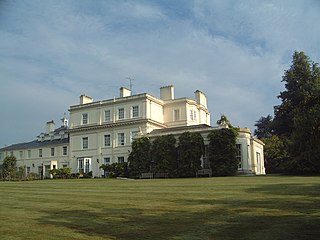
Viscount Cowdray, of Cowdray in the County of Sussex, is a title in the Peerage of the United Kingdom. It was created in 1917 for the industrialist Weetman Pearson, 1st Baron Cowdray, head of the Pearson conglomerate. He had already been created a Baronet, of Paddockhurst, in the Parish of Worth, in the County of Sussex, and of Airlie Gardens, in the Parish of St Mary Abbots, Kensington, in the County of London, on 26 June 1894, and Baron Cowdray, of Midhurst in the County of Sussex, in 1910. His son, the second Viscount, sat as a Liberal Member of Parliament for Eye. His son, the third Viscount, after serving in World War II where he lost an arm, was Chairman of the family firm of Pearson Plc from 1954 to 1977. The titles are held by the latter's son, the fourth Viscount, who succeeded in 1995.

Weetman Dickinson Pearson, 1st Viscount Cowdray,, known as Sir Weetman Pearson, Bt between 1894 and 1910, and as Lord Cowdray between 1910 and 1917, was a British engineer, oil industrialist, benefactor and Liberal politician. He was the owner of the Pearson conglomerate.

Brantridge Park, Balcombe, West Sussex, England is a 19th-century country house, formerly one of the lesser royal residences. It is a Grade II listed building.

The Royal Air Force Club, or RAF Club in short-form, is a club located at 128 Piccadilly, London.

Cowdray House consists of the ruins of one of England's great Tudor houses, architecturally comparable to many of the great palaces and country houses of that time. It is situated in the Parish of Easebourne, just east of Midhurst, West Sussex standing on the north bank of the River Rother. It was largely destroyed by fire on 24 September 1793, but the ruins have nevertheless been Grade I listed.

Cowdray Park is a country house at the centre of the 16,500-acre (6,700-hectare) Cowdray Estate in Midhurst, West Sussex.
Charles Torquil de Montalt Fraser was High Sheriff of West Sussex in 2006–07.

Weetman Harold Miller Pearson, 2nd Viscount Cowdray,, styled The Honourable Harold Pearson between 1910 and 1927, was a British peer and Liberal Party politician.
Baxtergate was a 7,072 GRT cargo ship that was built in 1944 as Empire Cowdray by Shipbuilding Corporation Ltd, Sunderland, United Kingdom. She was built for the Ministry of War Transport (MoWT). In 1948, she was sold into merchant service and renamed Granhill. A further sale in 1951 saw her renamed Baxtergate. She served until scrapped in 1960.

Robert May was an English professional chef who trained in France and worked in England. He is best known for writing and publishing the 1660 cookbook The Accomplisht Cook. It was the first major book of English recipes, and contains instructions for many soups and broths, as well as recipes for both sweet and savoury pies.
Michael Orlando Weetman Pearson, 4th Viscount Cowdray of Cowdray Park in West Sussex, is a landowner in West Sussex with 16,500 acres (6,700 ha) and is a major shareholder of the FTSE 100 company Pearson plc, the construction, now publishing, company founded by his ancestor in the 19th century.
Lt Col (Weetman) John Churchill Pearson, 3rd Viscount Cowdray was a British peer, businessman and polo player.

The Varsity Polo Match is an annual polo match between the Oxford University Polo Club and the Cambridge University Polo Club, played between teams of four players. Historically it was known as the inter-University Challenge Cup or inter-Varsity polo match. It is also known as the Oxford-Cambridge Polo Match or by a title that includes the name of its current sponsor. Members of both teams are traditionally known as Blues, with Oxford in dark blue and Cambridge in light blue.

The Queen Elizabeth Oak is a large sessile oak tree in Cowdray Park near the village of Lodsworth in the Western Weald, West Sussex, England. It lies within the South Downs National Park. It has a girth of 12.5–12.8 metres (41–42 ft), and is about 800–1,000 years old. According to this estimate it began to grow in the 11th or 12th century AD. In June 2002, The Tree Council designated the Queen Elizabeth Oak, one of fifty Great British Trees, in recognition of its place in the national heritage. According to the Woodland Trust, the tree is the third largest sessile oak tree to be recorded in the United Kingdom after the Pontfadog Oak in Wales and the Marton Oak in Cheshire, although this tree is now fragmented.
Christopher Cowdray is a Zimbabwean-born British hotel manager. He is the chief executive officer of the Dorchester Collection, a hotel operator in Europe and the US.

HMS Cowdray was a Type II Hunt-class destroyer of the Royal Navy which served in World War II. She has been the only Royal Navy ship to bear the name. She was scrapped in 1959.

The British Open Polo Championship for the Cowdray Gold Cup is an annual polo tournament held at Cowdray Park, West Sussex, England.

Annie Pearson, Viscountess Cowdray, GBE was an English society hostess, suffragist and philanthropist. She was nicknamed the "Fairy Godmother of Nursing" due to her financial patronage of the Royal College of Nursing and her work to promote district nursing throughout England and Scotland. She served as the President of the Women's Liberal Federation from 1921 until 1923 and was also the Honorary Treasurer of the Liberal Women's Suffrage Union. She was the only woman to hold the office of High Steward of Colchester, serving from 1927 until her death in 1932.













